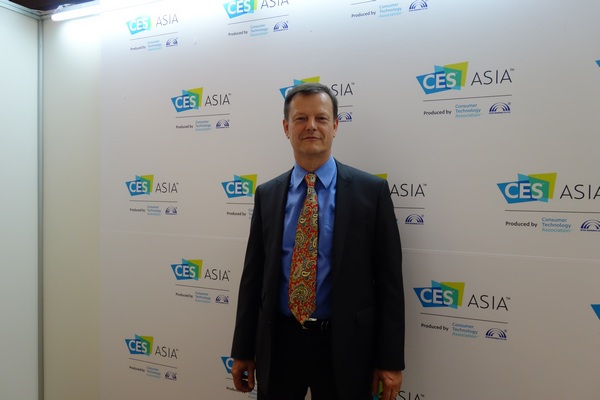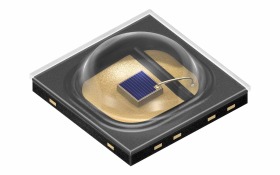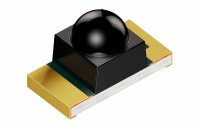(Author: Roger Chu, Research Director, LEDinside)
Construction of comprehensive optic fiber networks and maturing Internet technology are ushering innovative technology developments. LEDinside observed the emergence of more innovative technology products at CES Asia 2016, which took place in Shanghai, China recently. Growing number of products require the integration of IR sensor technologies, such as trending virtual reality (VR) headsets, or wearable fitness devices for measuring heart rates and pulse. IR sensor technology in man and machine interface is also playing an increasingly important role.
At the CES Asia 2016 forum, each manufacturer presented their future outlook for their products, advance technology in mobile applications was one of the topics discussed at the show. Christoph Goeltner, Product Marketing Manager, Infrared Products of Osram Opto Semiconductors also spoke to LEDinside about their perspective on IR sensor technology developments.
Goeltner highlighted major applications observed in the IR sensor industry: biosensors, position and motion tracking sensors, iris recognition, and facial recognition. Other main applications include 3D sensors, spectroscopy sensors. The technology for each application sector is developing at separate paces, and can be realized in the foreseeable future.
 |
|
Christoph Goeltner, Product Marketing Manager, Infrared Products of Osram Opto Semiconductors. (LEDinside) |
Upgrading IR LED biosensors accuracy could pave way to new applications
Currently, most biosensors are integrated into smart watches to measure a person’s heart rate and pulse. However, there has been few developments in this sector following the release of Apple Watch on the market. “This is mainly because current biosensor measurements are still no all very precise,” said Goeltner. To create innovative IR sensor applications, the efficiency of the optic sensor component needs to be improved, the wearable device’s software algorithm needs to be advanced, and LED manufacturers need to collaborate with operating system developers.
Why is accurate measurements so important, though? Goeltner explained if accurate heart rates can be detected and measured, abundant new information and applications can be derived from the data compiled. For instance, in the future it might even be possible to use heart rate measurements to deduce alcohol levels in the bloodstream, or tell if a car owner is too stressed and take preventive measures. For example some companies in US to incentivize employees to exercise more and give them wearable devices to monitor their progress. People who sign up for these programs then benefit from lower insurance rates.
 |
|
Osram's Oslon Black IR LED. (Photo courtesy of Osram) |
IR LEDs can enhance man machine interface interaction
Many technology products rely on IR sensors for user interaction, including iris recognition, and facial recognition used in computers or smartphones, adding an additional security layer to safeguarding personal information. VR devices also use a lot of IR sensor technology including position tracking, which allows users to interact with virtual images. Others might use eye tracking technology, which interprets data based on the eye’s focal point, and raises resolution in parts of the screen. This can improve user experience and make the entire experience seamless, will become one main focus of the technology development.
 |
|
Osram's IR Dragon Video Camera.(Photo courtesy of Osram) |
Incorporating 3D sensing technology in your smart phone
The next generation of 3D sensors are now so miniaturized that they can be integrated into handheld devices like smart phones. They consist of an IR Laser source, advanced holographic optics and a camera sensor.
The ability to create an accurate three dimensional model of your immediate environment opens countless new use cases for the consumer. Imagine shopping in the future, if you wanted to buy a closet all you need is to scan the closet with 3D sensing technology to determine whether the closet will fit in your bedroom.
 |
|
Osram's IR small emitters. |
Future applications for Spectroscopy sensors
Current spectroscopy sensors on the market are industrial scale machines with highly specialized tasks, for instance determining the properties of an atom, chemical concentration, material testing and other lab scale measurements.
Miniaturized broad band IR emitters in conjunction with specialized cameras and respective algorithms will soon become available for consumer applications.
Even though the technology seems to be in the distant future, however, there are clear market demands for the product, said Goeltner. He speculated each smartphone would be equipped with this type of feature within the next five years, so that even housewives will be able to pick out watermelons with higher juice content.
Corresponding ecosystem and basic knowledge key to Osram’s IR technology
The outlook of the IR sensor market is bright, many of the above mentioned applications are already being introduced to mass applications and many more are in the pipeline. Osram Opto’s is rapidly addressing new market opportunities with differentiated products, using its advantages is in the sensor component know how for IR emitters, photodiodes and package technologies, optic design capacity and others. The company accumulated significant basic knowledge in these areas, customization and designs. In addition to IR sensor components and hardware, Osram Opto is working closely with different algorithm developers and software system developers, in the ecosystem of all major consumer applications.














